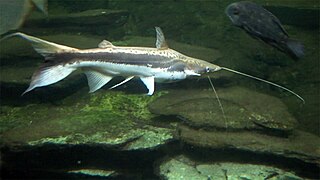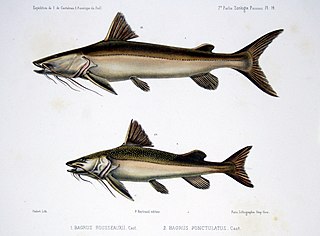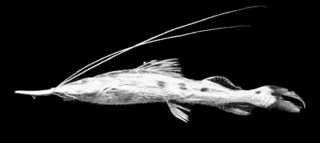
Catfish are a diverse group of ray-finned fish. Named for their prominent barbels, which resemble a cat's whiskers, catfish range in size and behavior from the three largest species alive, the Mekong giant catfish from Southeast Asia, the wels catfish of Eurasia, and the piraíba of South America, to detritivores, and even to a tiny parasitic species commonly called the candiru, Vandellia cirrhosa. Neither the armour-plated types nor the naked types have scales. Despite their name, not all catfish have prominent barbels or "whiskers". Members of the Siluriformes order are defined by features of the skull and swimbladder. Catfish are of considerable commercial importance; many of the larger species are farmed or fished for food. Many of the smaller species, particularly the genus Corydoras, are important in the aquarium hobby. Many catfish are nocturnal, but others are crepuscular or diurnal.

The Pimelodidae, commonly known as the long-whiskered catfishes, are a family of catfishes.

The Doradidae are a family of catfishes also known as thorny catfishes, raphael catfishes or talking catfishes. These fish are native to South America, primarily the Amazon basin and the Guianas.

The redtail catfish, Phractocephalus hemioliopterus, is a pimelodid (long-whiskered) catfish. In Venezuela, it is known as cajaro, and in Brazil, it is known as pirarara, stemming from the Tupi language words pirá and arara. It is the only extant species of the genus Phractocephalus. This fish is common in the aquarium trade, although its massive adult size makes it unsuitable for all but the largest aquariums. They feed on fish, crustaceans and fallen fruits. They are not evaluated by IUCN.

Aspidoras is a genus of catfishes of the family Callichthyidae from Brazil.
The Chiapas catfish, Lacantunia enigmatica, is an unusual species of catfish from the Usumacinta River basin in the Mexican state of Chiapas and in Guatemala. It was scientifically described in 2005 and placed in its own family Lacantuniidae. While discovery of an undescribed species of catfish is not uncommon, discovery of a new family of any vertebrate group is a rare event. The Chiapas catfish mainly feeds on crabs, prawns, small fish, and large, tough plant seeds. This catfish is commonly fished in its natural habitat, where it is known as madre de juil, which means "mother of Rhamdia".

Baryancistrus is a genus of freshwater Loricariid catfish. They inhabit flowing sections of rivers, especially clearwater, in the basins of the Amazon and Orinoco in Brazil and Venezuela. The largest species reach up to 34 cm (13 in) in total length.

Sorubim is a small genus of long-whiskered catfish native to tropical South America. A number of characteristics allows the differentiation of each species in the genus. Sorubim species are important food fish in South America and are highly significant to fisheries of some areas; however, harvests of these fish are not identified as much as other, more popular food fishes such as Colossoma, Arapaima, and Brachyplatystoma. Some species of this family are popular aquarium fish.

The Heptapteridae, or three-barbeled catfishes, are a family of catfish that originate from the Americas. Most species are restricted to South America, but Imparfinis lineatus, Nemuroglanis panamensis and Pimelodella chagresi are native to Panama, and Rhamdia species occur as far north as Mexico. The name Heptapteridae is derived from Greek, hepta meaning seven and pteron meaning fin.

Brachyplatystoma is a genus of catfish from the family Pimelodidae. As the occasionally used common name goliath catfishes indicates, this genus includes some of the largest species of catfish, including the piraíba, B. filamentosum, which reaches up to the region of 3.6 metres (12 ft) in length. Brachyplatystoma are found in the Amazon and Orinoco basins, and other tropical freshwater and brackish habitats in South America. Some species are migratory. These fish are important as food fish and, to some extent, aquarium fish.

Platystomatichthys sturio is the only species in the genus Platystomatichthys of the catfish family Pimelodidae. It is sometimes called the sturgeon catfish. This species occurs in the Amazon Basin and reaches a length of about 40.0 centimetres (15.7 in) TL. Platystomatichthys is classified under the "Calophysus-Pimelodus clade". Within this clade, it is considered a part of the "Pimelodus-group" of Pimelodids, which also includes Pimelodus, Exallodontus, Duopalatinus, Cheirocerus, Iheringichthys, Bergiaria, Bagropsis, Parapimelodus, Platysilurus, and Propimelodus.

Bagropsis reinhardti is a species of long-whiskered catfish. This species reaches about 22.7 cm (8.9 in) in standard length and is endemic to Brazil where it is found in the Das Velhas River basin in São Francisco River drainage. It is considered a threatened species by Brazil's Ministry of the Environment.
Exallodontus aguanai is a catfish species of the monotypic genus Exallodontus of the family Pimelodidae. This genus and species was described in 1991. This species reaches 20 centimetres (7.9 in) SL. This species is native to the Amazon and Orinoco River basins of Brazil, Colombia, Peru and Venezuela. Exallodontus is classified under the "Calophysus-Pimelodus clade". Within this clade, it is considered a part of the "Pimelodus-group" of Pimelodids, which also includes Pimelodus, Duopalatinus, Cheirocerus, Iheringichthys, Bergiaria, BagropsisParapimelodus, Platysilurus, Platystomatichthys, and Propimelodus.

The porthole shovelnose catfish or spotted shovelnose catfish, Hemisorubim platyrhynchos, is the only species in the genus Hemisorubim of the catfish family Pimelodidae.
Duopalatinus is a small genus of long-whiskered catfishes native to South America.

Platysilurus is a genus of long-whiskered catfishes native to South America.
Aguarunichthys is a genus of long-whiskered catfishes native to South America.

Pimelodus is a genus of fish in the family Pimelodidae native to Central and South America.
Pimelodus pohli is a species of catfish belonging to the family Pimelodidae. It is only found in the São Francisco River, Brazil, and its tributaries.
Brachyplatystoma capapretum, the dark caped goliath catfish, also called Peru piraiba catfish or false piraiba, is a species of catfish of the family Pimelodidae that is native to watershed areas of Brazil and Peru.













